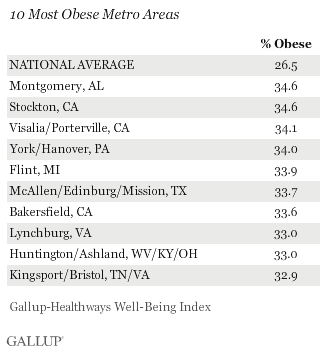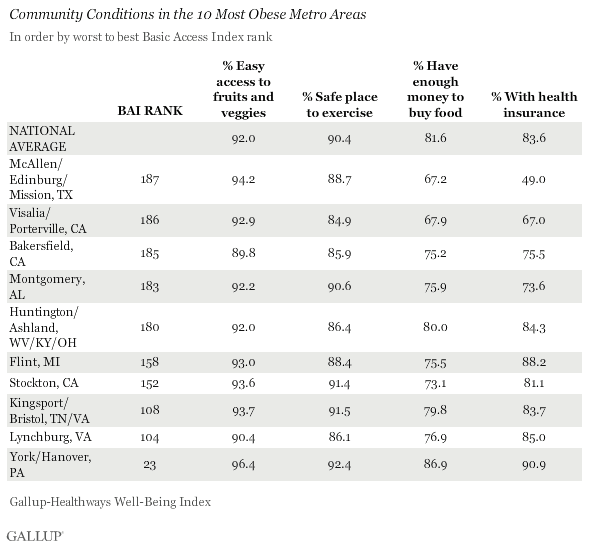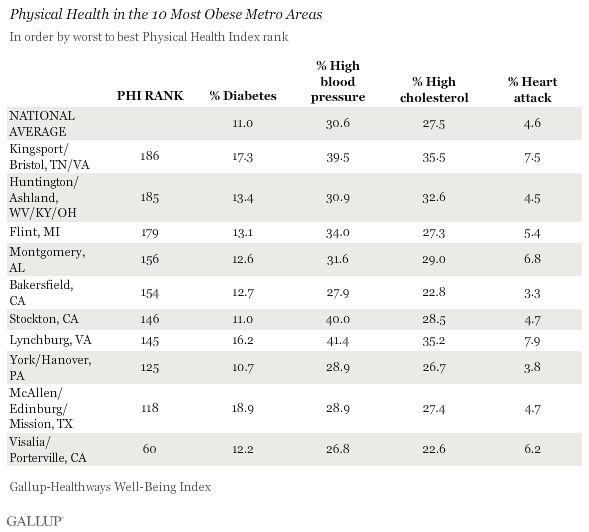���۴�ýand Healthways started collecting BMI data as part of the Well-Being Index in January of 2008 and surveyed in 187 metro areas in 2009. This is the first in a two-part series reviewing the most and least obese metro areas in the United States. ���۴�ýwill reveal the 10 least obese metro areas in part two of this series.
WASHINGTON, D.C. -- Montgomery, Ala., and Stockton Calif., tie for the most obese metro areas in the U.S., with adult obesity rates of 34.6% -- substantially surpassing the national average obesity rate of 26.5%. More than one-third of adults are classified as obese in the 10 metro areas found to be most obese according to Gallup-Healthways Well-Being Index collected in 2009.

���۴�ýtracks Americans' height and weight daily, and then determines obesity by calculating a respondents' Body Mass Index (BMI) based on these self-reports. The 26.5% found to be obese in the United States in 2009 is . Looking in-depth at the health-related behaviors, community conditions, and physical health across the 10 most obese metro areas reveals that on almost every item these 10 places rank among the bottom two-thirds of all 187 metro areas surveyed.
Ten Most Obese Places Need Improvement in Healthy Behaviors
���۴�ýand Healthways measure healthy behaviors in the United States by combining four metrics measuring Americans' eating, exercise, and smoking habits into the Healthy Behaviors Index. The results show that areas ranking high on obesity generally rank low on healthy behaviors. Specifically, all of the 10 most obese metro areas fall within the bottom two-thirds of all areas surveyed for frequent exercise. In terms of eating habits, of the 10 most obese places, seven are in the bottom two-thirds among all metro areas for reporting eating healthy "yesterday" and for fruit and vegetable consumption.

In addition to monitoring healthy behaviors, the Gallup-Healthways daily tracking includes measures of access to several conditions important to a healthy lifestyle: accessibility of fresh fruits and vegetables, having a safe place to exercise, having enough money to buy food, and having health insurance.
"Each of the 10 most obese metro areas surveyed are in the bottom two-thirds of all places in terms of diabetes."
Eight of the 10 most obese areas rank in the bottom two-thirds of all places measured in terms of easy access to fruits and vegetables and nine rank in the bottom two-thirds for having a safe place to exercise. Seven of the 10 most obese metro areas are among the bottom 25 places where residents say that there have been times in the past 12 months when they did not have enough money to buy food for themselves or their family.

Most Obese Places Suffering With Poor Physical Health
Obesity is often a precursor to chronic and costly health problems, including high blood pressure, high cholesterol, diabetes, and heart attack. These types of conditions are included in the ���۴�ýand Healthways daily tracking as part of the Physical Health Index, which consists of 18 items. Each of the 10 most obese metro areas surveyed are in the bottom two-thirds of all places in terms of diabetes. Huntington/Ashland, W. Va./Ky./Ohio, Montgomery, Ala., and Kingsport/Bristol, Tenn./Va., are in the bottom 10 among all metro areas surveyed in regard to high blood pressure, with rates nearly 10 percentage points higher than the national average. Huntington and Kingsport are also in the bottom 10 for high cholesterol, as is Lynchburg, Va. Again, Huntington and Kingsport are among the bottom 10 for heart attacks, with rates nearly twice the national average. On a positive note, 4 of the 10 most obese areas are in the top third among all metro areas for not smoking, but the other six rank in the bottom two-thirds.

Bottom Line
Obesity is widely considered to be an urgent and widespread health issue facing the United States. ���۴�ýfinds that obesity rates have increased marginally from 2008 to 2009, and that in the country's most obese places, these rates are close to one-third or more of the adult population. There is a growing recognition by health professionals, employers, and the government that obesity is a serious health problem that is linked to other chronic conditions. Many organizations have established wellbeing or health programs that attempt to reduce obesity among various groups in society, including first lady Michelle Obama's recently launched program to reduce obesity among children. Focusing on improving the exercise and eating habits in the nation's most obese places as well as improving their residents' access to healthy choices may be critical to helping Michelle Obama and others achieve their goals, reducing the prevalence not only of obesity, but also of chronic conditions.
Learn more about the .
Survey Methods
Results are based on telephone interviews with more than 353,000 American adults, aged 18 and older, conducted Jan. 2-Dec. 29, 2009.
For annual results based on the stated total sample of national adults, one can say with 95% confidence that the maximum margin of sampling error is ±0.2 percentage points.
The Metropolitan Statistical Areas (MSAs) that are characterized in this article are defined by the U.S. Office of Management and Budget. Maximum expected error ranges for the MSAs vary according to size, ranging from ±6.2% in small metro areas (n=350) to ±4.1% in medium/large metro areas (n=800).
Interviews are conducted with respondents on landline telephones (for respondents with a landline telephone) and cellular phones (for respondents who are cell phone only and cell phone mostly).
In addition to sampling error, question wording and practical difficulties in conducting surveys can introduce error or bias into the findings of public opinion polls.
About the Gallup-Healthways Well-Being Index™
The Gallup-Healthways Well-Being Index measures the daily pulse of U.S. wellbeing and provides best-in-class solutions for a healthier world. To learn more, please visit .
